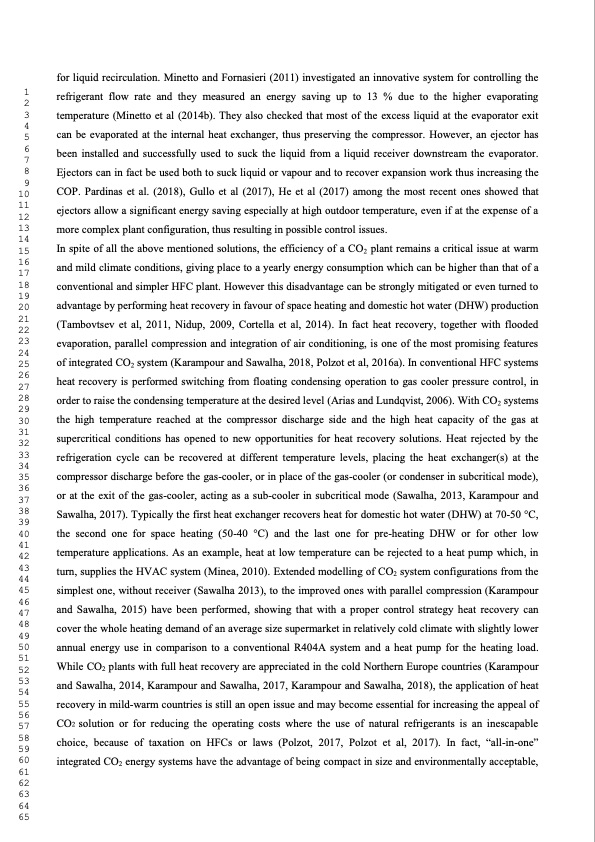
PDF Publication Title:
Text from PDF Page: 004
for liquid recirculation. Minetto and Fornasieri (2011) investigated an innovative system for controlling the refrigerant flow rate and they measured an energy saving up to 13 % due to the higher evaporating temperature (Minetto et al (2014b). They also checked that most of the excess liquid at the evaporator exit can be evaporated at the internal heat exchanger, thus preserving the compressor. However, an ejector has been installed and successfully used to suck the liquid from a liquid receiver downstream the evaporator. Ejectors can in fact be used both to suck liquid or vapour and to recover expansion work thus increasing the COP. Pardinas et al. (2018), Gullo et al (2017), He et al (2017) among the most recent ones showed that ejectors allow a significant energy saving especially at high outdoor temperature, even if at the expense of a more complex plant configuration, thus resulting in possible control issues. 14 In spite of all the above mentioned solutions, the efficiency of a CO plant remains a critical issue at warm 15 2 1 2 3 4 5 6 7 8 9 10 11 12 13 16 17 18 19 20 advantage by performing heat recovery in favour of space heating and domestic hot water (DHW) production 21 57 58 59 60 61 62 63 64 65 CO2 solution or for reducing the operating costs where the use of natural refrigerants is an inescapable and mild climate conditions, giving place to a yearly energy consumption which can be higher than that of a conventional and simpler HFC plant. However this disadvantage can be strongly mitigated or even turned to (Tambovtsev et al, 2011, Nidup, 2009, Cortella et al, 2014). In fact heat recovery, together with flooded evaporation, parallel compression and integration of air conditioning, is one of the most promising features 22 23 24 25 of integrated CO2 system (Karampour and Sawalha, 2018, Polzot et al, 2016a). In conventional HFC systems 26 heat recovery is performed switching from floating condensing operation to gas cooler pressure control, in 27 28 29 30 the high temperature reached at the compressor discharge side and the high heat capacity of the gas at 31 order to raise the condensing temperature at the desired level (Arias and Lundqvist, 2006). With CO2 systems supercritical conditions has opened to new opportunities for heat recovery solutions. Heat rejected by the 32 33 34 35 compressor discharge before the gas-cooler, or in place of the gas-cooler (or condenser in subcritical mode), 36 refrigeration cycle can be recovered at different temperature levels, placing the heat exchanger(s) at the or at the exit of the gas-cooler, acting as a sub-cooler in subcritical mode (Sawalha, 2013, Karampour and 37 38 39 40 the second one for space heating (50-40 °C) and the last one for pre-heating DHW or for other low 41 Sawalha, 2017). Typically the first heat exchanger recovers heat for domestic hot water (DHW) at 70-50 °C, temperature applications. As an example, heat at low temperature can be rejected to a heat pump which, in 42 43 44 45 simplest one, without receiver (Sawalha 2013), to the improved ones with parallel compression (Karampour 46 turn, supplies the HVAC system (Minea, 2010). Extended modelling of CO2 system configurations from the and Sawalha, 2015) have been performed, showing that with a proper control strategy heat recovery can 47 48 49 50 annual energy use in comparison to a conventional R404A system and a heat pump for the heating load. 51 cover the whole heating demand of an average size supermarket in relatively cold climate with slightly lower While CO2 plants with full heat recovery are appreciated in the cold Northern Europe countries (Karampour 52 53 54 55 recovery in mild-warm countries is still an open issue and may become essential for increasing the appeal of 56 choice, because of taxation on HFCs or laws (Polzot, 2017, Polzot et al, 2017). In fact, “all-in-one” integrated CO2 energy systems have the advantage of being compact in size and environmentally acceptable, and Sawalha, 2014, Karampour and Sawalha, 2017, Karampour and Sawalha, 2018), the application of heatPDF Image | R744 BOOSTER INTEGRATED SYSTEM

PDF Search Title:
R744 BOOSTER INTEGRATED SYSTEMOriginal File Name Searched:
rj34_sub.pdfDIY PDF Search: Google It | Yahoo | Bing
CO2 Organic Rankine Cycle Experimenter Platform The supercritical CO2 phase change system is both a heat pump and organic rankine cycle which can be used for those purposes and as a supercritical extractor for advanced subcritical and supercritical extraction technology. Uses include producing nanoparticles, precious metal CO2 extraction, lithium battery recycling, and other applications... More Info
Heat Pumps CO2 ORC Heat Pump System Platform More Info
| CONTACT TEL: 608-238-6001 Email: greg@infinityturbine.com | RSS | AMP |